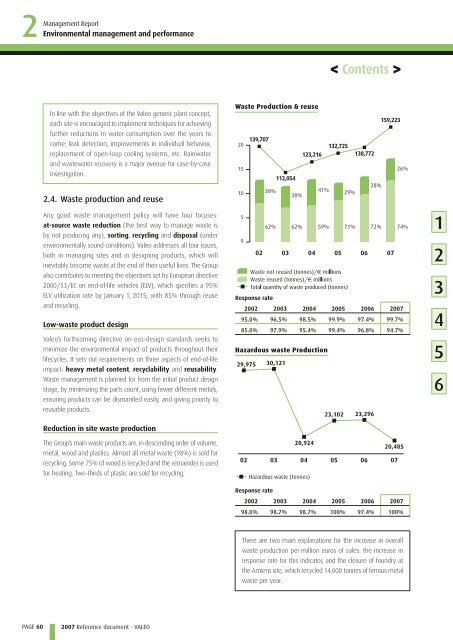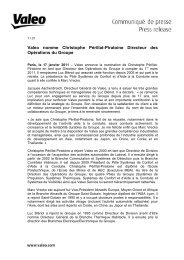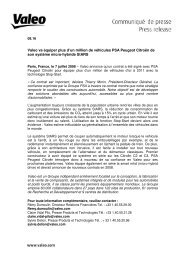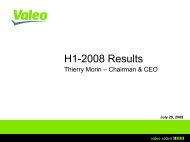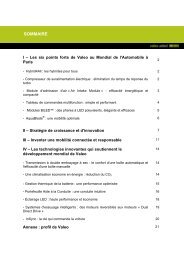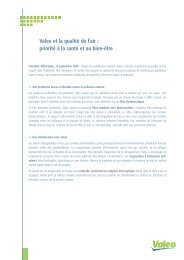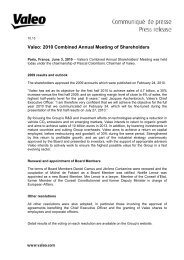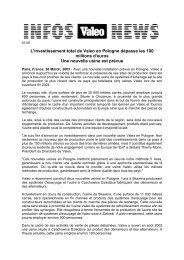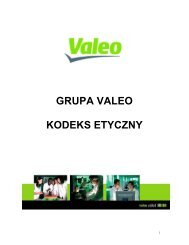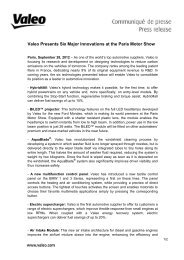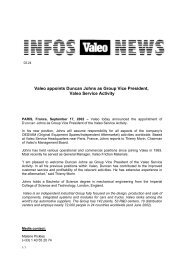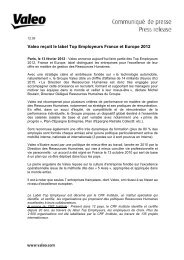2007 Reference document (PDF) - Valeo
2007 Reference document (PDF) - Valeo
2007 Reference document (PDF) - Valeo
Create successful ePaper yourself
Turn your PDF publications into a flip-book with our unique Google optimized e-Paper software.
2 Management<br />
PAGE 60<br />
Report<br />
Environmental management and performance<br />
In line with the objectives of the <strong>Valeo</strong> generic plant concept,<br />
each site is encouraged to implement techniques for achieving<br />
further reductions in water consumption over the years to<br />
come: leak detection, improvements in individual behavior,<br />
replacement of open-loop cooling systems, etc. Rainwater<br />
and wastewater recovery is a major avenue for case-by-case<br />
investigation.<br />
2.4. Waste production and reuse<br />
Any good waste management policy will have four focuses:<br />
at-source waste reduction (the best way to manage waste is<br />
by not producing any), sorting, recycling and disposal (under<br />
environmentally sound conditions). <strong>Valeo</strong> addresses all four issues,<br />
both in managing sites and in designing products, which will<br />
inevitably become waste at the end of their useful lives. The Group<br />
also contributes to meeting the objectives set by E uropean directive<br />
2000/53/EC on end-of-life vehicles (ELV), which specifies a 95%<br />
ELV utilization rate by January 1, 2015, with 85% through reuse<br />
and recycling.<br />
Low-waste product design<br />
<strong>Valeo</strong>’s forthcoming directive on eco-design standards seeks to<br />
minimize the environmental impact of products throughout their<br />
lifecycles. It sets out requirements on three aspects of end-of-life<br />
impact: heavy metal content, recyclability and reusability.<br />
Waste management is planned for from the initial product design<br />
stage, by minimizing the parts count, using fewer different metals,<br />
ensuring products can be dismantled easily, and giving priority to<br />
reusable products.<br />
Reduction in site waste production<br />
The Group’s main waste products are, in descending order of volume,<br />
metal, wood and plastics. Almost all metal waste (98%) is sold for<br />
recycling. Some 75% of wood is recycled and the remainder is used<br />
for heating. Two-thirds of plastic are sold for recycling.<br />
<strong>2007</strong> <strong>Reference</strong> <strong>document</strong> - VALEO<br />
Waste Production & reuse<br />
Response rate<br />
2002 2003 2004 2005 2006 <strong>2007</strong><br />
95.0% 96.5% 98.5% 99.9% 97.4% 99.7%<br />
85.0% 97.9% 95.4% 99.4% 96.8% 94.7%<br />
Hazardous waste Production<br />
< Contents ><br />
Response rate<br />
2002 2003 2004 2005 2006 <strong>2007</strong><br />
98.0% 98.7% 98.7% 100% 97.4% 100%<br />
There are two main explanations for the increase in overall<br />
waste production per million euros of sales: the increase in<br />
response rate for this indicator, and the closure of foundry at<br />
the Amiens site, which recycled 14,000 tonnes of ferrous metal<br />
waste per year.<br />
1<br />
2<br />
3<br />
4<br />
5<br />
6


